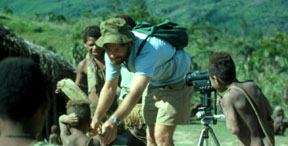I was fortunate enough to be able to attend an excellent talk by Dr. Geoffrey Saxe titled “Cultural Development of Mathematical Ideas: Papua New Guinea Studies”, part of the Thought and Culture Seminar at Laurentian University. This lecture touched on a number of interests of mine relating to thought, culture, and language. Here’s the abstract for the talk:
Psychological studies of cognitive development are often conducted without regard for the interplay between the cognitive activities of individuals and the cultural histories of communities. In my talk, I illustrate a heuristic research framework that illuminates this interplay through studies drawn from a program of work conducted in a remote Mountain Ok community in Papua New Guinea, the Oksapmin. Traditionally, the Oksapmin like their neighboring groups use a 27-body part counting system to represent quantity. Over three periods of fieldwork that stretch 23 years, I trace the shifting organization of the system and the shifting functions it serves as it is reproduced and altered in collective practices of daily life. Though the focus of the talk is on the Oksapmin case, I point to ways that the framework is useful for understanding the dynamics of culture-cognition relations more generally.
The research page of Dr. Saxe’s website has a good brief summary of the two lines of his research, and the publications page has this more detailed account of his research into the Oksapmin 27-body part counting system.

To summarise, Saxe looked at the counting system of the Oksapmin, in which numbers correspond to 27 body parts of the arms and head, as in this illustration taken from the website:
![The Oksapmin counting system. The conventional sequence of body parts used by the Oksapmin. In order of occurrence: (1) tip^na [thumb], (2) tipnarip [index finger], (3) bum rip [middle finger], (4) h^tdip [ring finger], (5) h^th^ta [pinky], (6) dopa [wrist], (7) besa [forearm], (8) kir [elbow], (9) tow^t [biceps], (10) kata [shoulder], (11) gwer [neck], (12) nata [ear], (13) kina [eye], (14) aruma [nose], (15) tan-kina [eye on other side], (16) tan-nata [ear on other side], (17) tan-gwer [neck on other side], (18) tan-kata [shoulder on other side], (19) tan-tow^t [biceps on other side], (20) tan-kir [elbow on other side], (21) tan-besa [forearm on other side], (22) tan-dopa [wrist on other side], (23) tan-tip^na [thumb on other side], (24) tan-tipnarip [index finger on other side], (25) tan-bum rip [middle finger on other side], (26) tan-h^tdip [ring finger on other side], (27) tan-h^th^ta.s [pinky on other side]. The Oksapmin counting system](http://endlessround.files.wordpress.com/2012/03/oksapmin01.gif)
These are cardinal numbers that are used to count, but Saxe found that traditionally they were not used for arithmetical calculation. In this brief video clip, on Saxe’s website, you can see this counting system being demonstrated.
The Oksapmin were first contacted by westerners in 1938, and gradually western culture has influenced Oksapmin society since then. Saxe has made three visits to study the Oksapmin and observe the changes in their traditional counting system, in 1978, 1980, and 2001. Two major influences on change are financial transaction, as the Oksapmin became more and more integrated with western economy, and education, as western-style schools were established in the region. For basic counting tasks, the traditional system could be used for counting out money, but more complex arithmetical calculations novel adaptations of the system began to be developed, many of them quite ingenious workarounds. Unsurprisingly, Saxe found that the more integrated a person was with western culture, the better they would be able to perform such arithmetical tasks, especially without a physical object to count, such as coins. In terms of education, initially the educational policy was to ban the use of any language other than English in the classroom. Saxe reports, therefore, that the traditional use of the body-part system was on the wane by his 2001 visit. However, educational policy had changed, and greater value was attached to traditional culture and practices, and attempts were being made to bridge traditional and western culture, rather than simply suppress the traditional. Thus the body-part system began to be used in the classroom. However, as the body-part system was no longer in much use in traditional contexts, the use in the classroom was somewhat divorced from the older tradition.
I am, of course, summarising and simplifying here, and no doubt I am missing many of the subtleties and complexities of Dr. Saxe’s research, as I only had a chance to briefly look over the article before the presentation, though I look forward to reading it more carefully now. If you’re interested in the subject, I recommend you read for yourself the article itself (as well as his other research).
Some particular questions / areas of interest I have about this research include the issue of bilingualism. Greater knowledge of western culture goes along with differences in use of the number system. Do bilingual speakers perform differently when performing the same tasks in different linguistic contexts, and does learning a different number system change the way one uses the traditional one? The evidence here seems to suggest yes. Another small question I have is do the Oksapmin use words for right and left -- the counting system outlined above seems to use an expression ('tan') meaning “on the other side” -- and does this have any bearing on things.
Ultimately Dr. Saxe’s work seeks to develop a framework for dealing with the complex cultural and cognitive interplay at work here, and how this leads to changes in knowledge systems over time. He noted the lack of inclusion of social history in the study of cognitive development, for which he thus tried to develop a working model. Obviously this could have very broad implications and utility to other situations, and is particularly relevant to my own interests in the interplay between culture, cognition, history, and language change, and so I look forward to learning more about his work.
